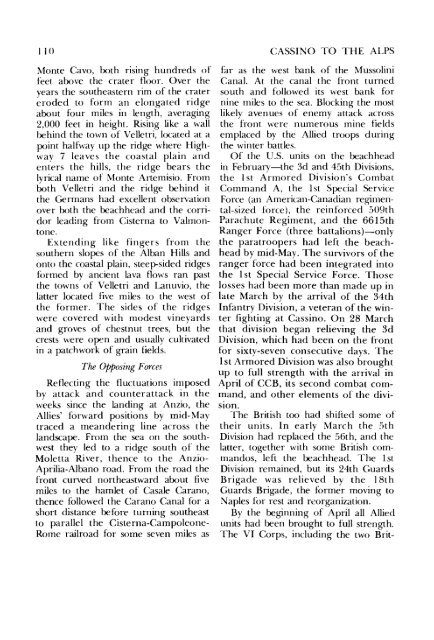Cassino to the Alps - US Army Center Of Military History
Cassino to the Alps - US Army Center Of Military History
Cassino to the Alps - US Army Center Of Military History
You also want an ePaper? Increase the reach of your titles
YUMPU automatically turns print PDFs into web optimized ePapers that Google loves.
110<br />
Monte Cavo, both rIsmg hundreds of<br />
feet above <strong>the</strong> crater floor. Over <strong>the</strong><br />
years <strong>the</strong> sou<strong>the</strong>astern rim of <strong>the</strong> crater<br />
eroded <strong>to</strong> form an elongated ridge<br />
about four miles in length, averaging<br />
2,000 feet in height. Rising like a wall<br />
behind <strong>the</strong> <strong>to</strong>wn of Velletri, l(x:ated at a<br />
point halfway up <strong>the</strong> ridge where Highway<br />
7 leaves <strong>the</strong> coastal plain and<br />
enters <strong>the</strong> hills, <strong>the</strong> ridge bears <strong>the</strong><br />
lyrical name of Monte Artemisio. From<br />
both Velletri and <strong>the</strong> ridge behind it<br />
<strong>the</strong> Germans had excellent observation<br />
over !xJth <strong>the</strong> beachhead and <strong>the</strong> corridor<br />
leading from Cisterna <strong>to</strong> Valmon<strong>to</strong>ne.<br />
Extending like fingers from <strong>the</strong><br />
sou<strong>the</strong>rn slopes of <strong>the</strong> Alban Hills and<br />
on<strong>to</strong> <strong>the</strong> coastal plain, steep-sided ridges<br />
formed by ancient lava flows ran past<br />
<strong>the</strong> <strong>to</strong>wns of Velletri and Lanuvio, <strong>the</strong><br />
latter located five miles <strong>to</strong> <strong>the</strong> west of<br />
<strong>the</strong> former. The sides of <strong>the</strong> ridges<br />
were covered with modest vineyards<br />
and groves of chestnut trees, but <strong>the</strong><br />
crests were open and usually cultivated<br />
in a patchwork of grain fields.<br />
The Opposing Forces<br />
Reflecting <strong>the</strong> Huctuations imposed<br />
by attack and counterattack in <strong>the</strong><br />
weeks since <strong>the</strong> landing at Anzio, <strong>the</strong><br />
Allies' forward positions by mid-May<br />
traced a meandering line across <strong>the</strong><br />
landscape. From <strong>the</strong> sea on <strong>the</strong> southwest<br />
<strong>the</strong>y led <strong>to</strong> a ridge south of <strong>the</strong><br />
Moletta River, <strong>the</strong>nce <strong>to</strong> <strong>the</strong> Anzio<br />
Aprilia-Albano road. From <strong>the</strong> road <strong>the</strong><br />
front curved nor<strong>the</strong>astward about five<br />
miles <strong>to</strong> <strong>the</strong> hamlet of Casale Carano,<br />
<strong>the</strong>nce followed <strong>the</strong> Carano Canal for a<br />
short distance before turning sou<strong>the</strong>ast<br />
<strong>to</strong> parallel <strong>the</strong> Cisterna-Campoleone<br />
Rome railroad for some seven miles as<br />
CASSINO TO THE ALPS<br />
far as <strong>the</strong> west bank of <strong>the</strong> Mussolini<br />
Canal. At <strong>the</strong> canal <strong>the</strong> front turned<br />
south and followed its west bank for<br />
nine miles <strong>to</strong> <strong>the</strong> sea. Blocking <strong>the</strong> most<br />
likely avenues of enemy attack across<br />
<strong>the</strong> front were numerous mine fields<br />
emplaced by <strong>the</strong> Allied troops during<br />
<strong>the</strong> winter battles.<br />
<strong>Of</strong> <strong>the</strong> U.S. units on <strong>the</strong> beachhead<br />
in Februarv-<strong>the</strong> 3d and 45th Divisions,<br />
<strong>the</strong> 1st A'rmored Division's Combat<br />
Command A, <strong>the</strong> 1st Special Service<br />
Force (an American-Canadian regimental-sized<br />
force), <strong>the</strong> reinforced 509th<br />
Parachute Regiment, and <strong>the</strong> 6615th<br />
Ranger Force (three battalions)-only<br />
<strong>the</strong> paratroopers had left <strong>the</strong> beachhead<br />
by mid-May. The survivors of <strong>the</strong><br />
ranger force had been integrated in<strong>to</strong><br />
<strong>the</strong> 1st Special Service Force. Those<br />
losses had been more than made up in<br />
late March by <strong>the</strong> arrival of <strong>the</strong> 34th<br />
Infantry Division, a veteran of <strong>the</strong> winter<br />
fighting at <strong>Cassino</strong>. On 28 March<br />
that division began relieving <strong>the</strong> 3d<br />
Division, which had been on <strong>the</strong> front<br />
for sixty-seven consecutive days. The<br />
1st Armored Division was also brought<br />
up <strong>to</strong> full strength with <strong>the</strong> arrival in<br />
April of CCB, its second combat command,<br />
and o<strong>the</strong>r elements of <strong>the</strong> divi<br />
SIOn.<br />
The British <strong>to</strong>o had shifted some of<br />
<strong>the</strong>ir units. In early March <strong>the</strong> 5th<br />
Division had replaced <strong>the</strong> 56th, and <strong>the</strong><br />
latter, <strong>to</strong>ge<strong>the</strong>r with some British commandos,<br />
left <strong>the</strong> beachhead. The 1 st<br />
Division remained, but its 24th Guards<br />
Brigade was relieved by <strong>the</strong> 18th<br />
Guards Brigade, <strong>the</strong> former moving <strong>to</strong><br />
:-.Japles for rest and reorganization.<br />
By <strong>the</strong> bebrinning of April all Allied<br />
units had been brought <strong>to</strong> full strength.<br />
The VI Corps, including <strong>the</strong> two Brit-
















